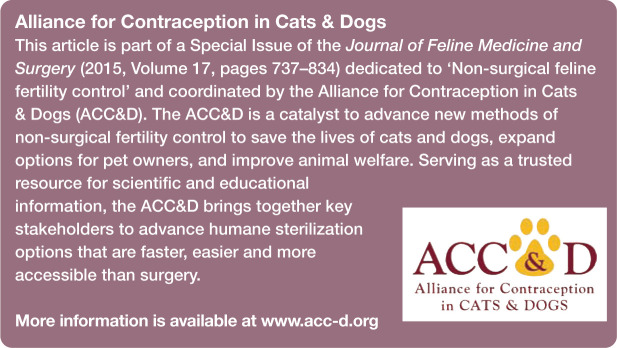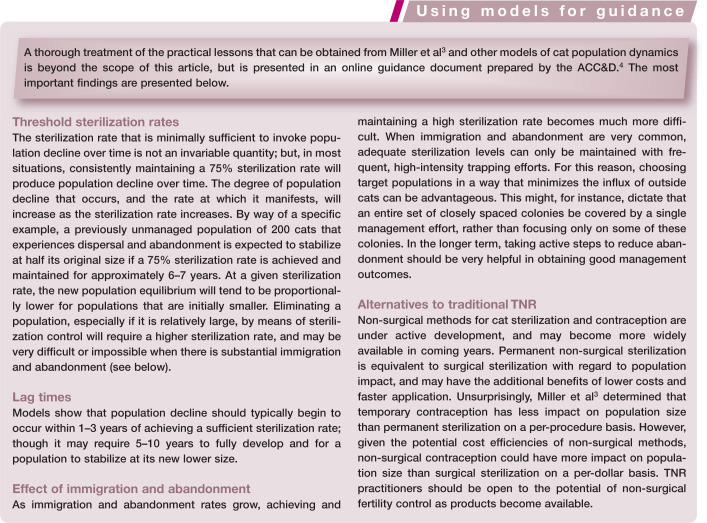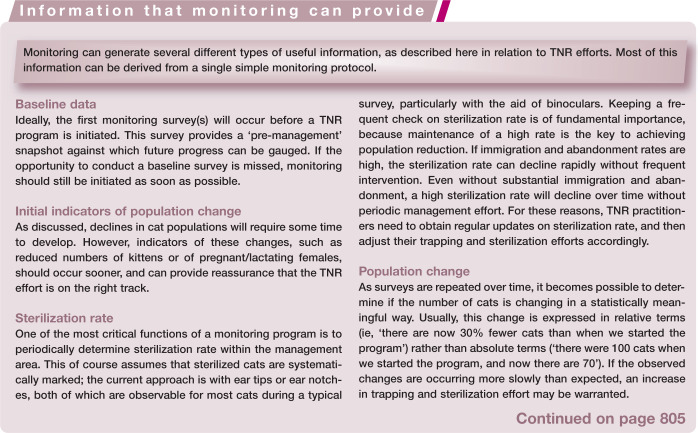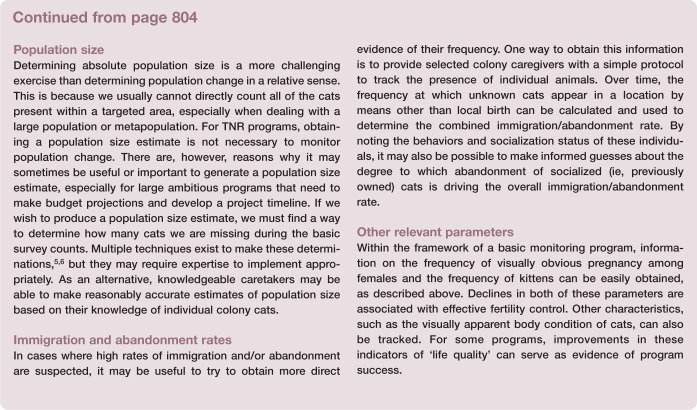Abstract
Overview:
Trap–neuter–return (TNR) for cat management is transitioning from an enterprise driven mainly by an urge to ‘help’ into an enterprise that draws useful guidance and precedent from the fields of population biology and wildlife management. This transition is in its infancy, however. At the present time many TNR programs do not produce substantial and persistent reductions in cat populations, and those that do often fail to effectively document this achievement or to publicize their success.
Challenges:
As a result, TNR has become increasingly controversial, with TNR advocates and wildlife conservationists often staking out fundamentally incompatible positions. This may ultimately prove to be an unproductive debate, since public opinion in developed countries is unlikely to support a total abandonment of TNR in favor of widespread cat management using lethal methods, and since wildlife advocates are unlikely to support TNR as it is typically practiced.
Advancements:
In contrast, improving the effectiveness of TNR as a population management tool can benefit both cats and wildlife, potentially on a broad scale. Making these advancements requires the diligent promotion, dissemination and adoption of tools like population modeling, population monitoring and adaptive management. By virtue of their training and exposure to the scientific method, veterinarians are uniquely well positioned to translate the more technical aspects of these approaches to TNR practitioners, and to facilitate their wider use.
Aim:
The purpose of this review is to describe for a veterinary audience how to facilitate more effective sterilization-based management of outdoor cats, using a combination of theoretical knowledge derived from population modeling and empirical knowledge derived from population monitoring. Using both of these information sources synergistically can offer a viable pathway to better management outcomes.
Introduction
In all likelihood, sterilizing an outdoor cat gives that individual a better quality of life. Additionally, if the cat is a female, the sterilization almost certainly prevents many kittens from being born. Does that same sterilization, however, help to reduce the number of outdoor cats? The intuitive answer to that question is ‘yes, by preventing multiple kittens from being born, we must be helping to reduce the number of cats’. The actual answer, however, is far more conditional, and depends on the processes that govern biological populations in general and outdoor cat populations in particular. The unfortunate reality is that many sterilizations currently being performed on outdoor cats have no significant impact on population size, and that consequently trap–neuter–return (TNR) cat management programs have come under increasing criticism and scrutiny. 1 However, this does not have to remain the status quo. Over recent years, animal welfare organizations have begun to pay increasing attention to lessons from the fields of population biology and wildlife management, lessons that have the potential to make the reduction of outdoor cat populations via fertility control an increasingly common – and increasingly well documented – phenomenon. In order to realize this potential, these lessons must be widely communicated and applied.
Veterinarians play a critical role in TNR programs at the clinical level, and are often involved at the administrative and planning levels as well. Veterinarians are, of course, well versed in the organismal biology of cats, sterilization procedures and the effects of these procedures on the individual animal. Populations (simply defined as a group of interacting, interbreeding individuals), however, are very different entities from individuals, and they exhibit properties and dynamics that are not predictable from knowledge of organismal biology (see later). Successfully achieving population-level goals requires that we understand the biology of populations just as we understand the biology of individual animals. Veterinarians, by virtue of their technical training and exposure to the scientific method, have the capacity to constructively incorporate the critical elements of population biology into TNR practice.
Models
Models are simplified representations of a system of interest that are created to make that system easier to understand and explore. They can be mathematical equations, statistical relationships, or simulations in which the system is represented virtually in computer code. Models in biology (especially population models) can never capture all of the complexity and ‘messiness’ present in the real world, and will therefore provide only approximations of the scenarios we will actually encounter. However, insights derived from well-constructed models can give us a meaningful understanding of the requirements for effective population control, and offer a valuable short-cut to the decades of trial and error that would be required to obtain the same insights empirically.
The following discussion begins by introducing some of the ‘stark realities’ of population biology that population models aspire to emulate (and TNR practitioners often struggle to overcome). There then follows a description of how cat-specific modeling has been used to better understand these complexities and deliver practical guidance for more effective management interventions.
Population biology – some stark realities
Reality #1: the ‘doomed surplus’ and carrying capacity
Students of population biology are inevitably exposed early on to the paired concepts of ‘K-selection’ and ‘r-selection’. These terms represent different ends of a spectrum of evolutionary adaptation with regard to reproductive strategy.
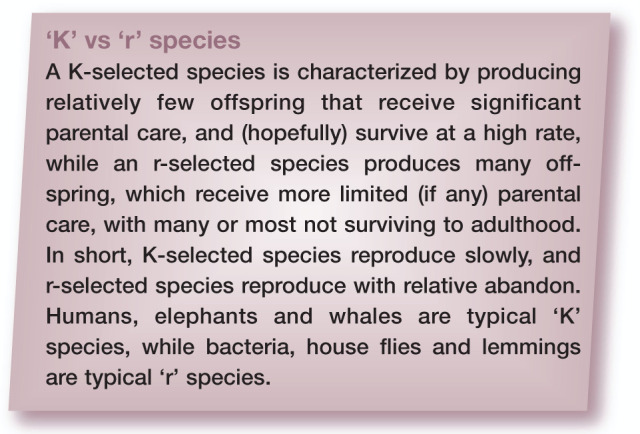
The ‘K’ and ‘r’ concepts are most appropriately used in a relative sense and, within the world of mammals, free-roaming cats (in contrast to their wild ancestors) exhibit ‘r’ type characteristics, with a healthy female cat capable of producing several dozen offspring during her lifespan. 2 Each kitten receives only a relatively short period of parental care, after which it becomes independent and begins reproducing at a relatively young age. In an outdoor setting, most of these kittens do not survive to adulthood; if they did, the world would literally be awash with cats. The environment simply does not have the capacity to support all of these kittens, and the ‘doomed surplus’ die early by various mechanisms in an inexorable adherence to these ecological limits. These limits, which may vary from place to place and across time, are collectively encompassed in the concept of ‘carrying capacity’, which can be defined as the number (or density) of individuals that the local environment can, on average, support.
The significance of this concept for cat management is as follows: sterilization efforts in places where a cat population is at or close to its carrying capacity will initially serve to prevent the birth of kittens that are fated to be part of the doomed surplus. Until sterilization rates reach a threshold level which effectively eliminates these ‘excess’ kittens, population size reduction is not possible.
Reality #2: lag times
Assuming that the births of the doomed surplus have been prevented by a sufficiently high rate of sterilization, we might expect that additional sterilization efforts should rapidly reduce population size. Here population dynamics has another reality in store for us; namely, that the population-level effects of high sterilization rates are not manifested immediately, but only become apparent after significant lag times. To understand why this is so, imagine a free-roaming cat population in which every cat is suddenly sterilized. Upon being returned to the colony site, population size will be no different than it was prior to sterilization. Population decline will only occur as existing adults die, and then fail to be replaced by kittens, a process that occurs over years.
Reality #3: immigration and abandonment
If high sterilization rates have been achieved, and we are expecting population decline to manifest, the appearance of a few unsterilized immigrants or abandoned cats can greatly delay this expected decline. Steady immigration and abandonment, in effect, is constantly diluting the sterilization rate of the overall population, and constitutes one of the most significant impediments to reducing population size. In most settings, cats exist in the form of a ‘metapopulation’, which is an array of distinct groups, or populations, that are connected by periodic movements of individuals from one population to another, as illustrated in Figure 1. In most places (with the exception of islands or other isolated locations), some degree of cat emigration and immigration must be expected. Compounding this difficulty, as a local population is driven below its carrying capacity, immigrants and abandoned cats become progressively more likely to successfully ‘settle’ within the vacated resource space; this is one of many ways in which population dynamics may shift as the density of cats rises or falls (usually to the detriment of population control efforts). For these reasons, successful TNR programs must be prepared to overcome the effects of cat movements and abandonment.
Figure 1.
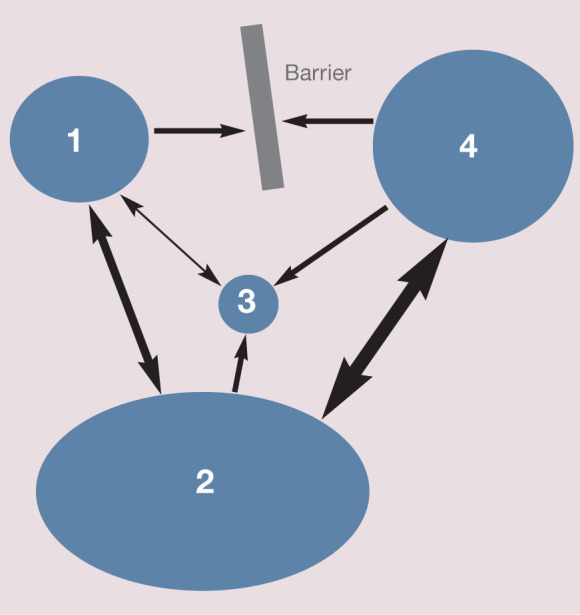
Diagram of an idealized metapopulation. Each numbered circle represents a distinct population (or colony), with circle size proportional to population size. Most populations are connected by periodic exchange of individuals, which may be unilateral (single-headed arrows) or bilateral (doubleheaded arrows), and which can occur frequently (wide arrows) or infrequently (narrow arrows). Movements between some populations may be effectively blocked or limited by physical barriers, such as rivers or major highways
Reality #4: the ‘vacuum’ effect
The so-called ‘vacuum effect’ is a process whereby new cats tend to replace those that disappear or are removed from a population. Although it is most often mentioned as a potential by-product of traditional ‘trap and euthanize’ animal control practices, it is in fact just as likely to occur as a by-product of successful TNR programs. As a population falls below its carrying capacity, whether due to lethal removal, TNR or other factors, resource space becomes available, and that space is likely to be filled if there are kittens, immigrating cats or abandoned cats present in the same area. Assuming that we are attempting to reduce population size, the only ways to avoid a potential vacuum effect are to ensure that there are too few locally born kittens or immigrants to fill the vacated space and/or to reduce carrying capacity along with population size.
Reality #5: reversion
Once achieved, a high sterilization rate must be perpetually maintained by active management in order to produce lasting population change. Functionally speaking, this means that a successful TNR program will need to conduct periodic assessments of current sterilization rate and population size (see later), and trap and sterilize cats as needed so that the sterilization rate does not fall appreciably below the targeted sterilization rate for any extended period of time. If it does, the population will begin to grow much more rapidly than it declined.
Synthesizing reality in models
Cat populations are inherently resistant to the kind of population-level change we hope to effect, through the mechanisms described above. Although these challenges are very real and substantial, they are not necessarily intractable. Overcoming them requires us to synthesize our knowledge of population dynamics into a usable framework and, from there, to generate practical guidelines for gaining control of populations. Most often, this process involves constructing models, which can take many forms. For the purposes of this discussion, we focus on simulation modeling. A simulation model that adequately mimics the functioning of a real population offers us an opportunity to explore different approaches to population management that are limited only by our imagination, and to determine the specific parameters most likely to make the difference between success and failure.
Recently, a multidisciplinary group organized by the Alliance for Contraception in Cats & Dogs (ACC&D) published a comprehensive cat population model that captures the complexities of population function that are described above, incorporates realistic age-specific survival and reproduction rates, and addresses the impact of immigration and abandonment. 3 Several different management approaches were compared within this framework (surgical sterilization, non-surgical contraception and removal) in order to determine critical sterilization threshold rates, expected lag times for population response, and expected degree of population decline given different treatment intensities. Interested readers can refer to this publication directly, 3 highlights of which are summarized in the box above.
Monitoring
Insights derived from modeling or other analytical exercises will always be somewhat generalized in nature, and will never completely account for important local factors and contingencies. Therefore, any effective management program needs to undertake periodic standardized ‘reality checks’ to determine what is actually happening over time. These reality checks are referred to as ‘population monitoring’.
A well-designed population monitoring effort allows us to determine whether our program is on track, and provides ongoing opportunities to adjust our management practices to produce the desired outcome. It also supplies the critical objective documentation of program impact that is now required by many funding organizations. A full treatment of monitoring practice is beyond the scope of this article, but some key characteristics of effective monitoring programs, and the types of information that monitoring can provide, are described in the following sections. The ACC&D has recently posted detailed online guidelines for cat population monitoring. 5 Interested readers may wish to examine the online document in conjunction with this article, or consult more generalized discussions of monitoring design and practice. 6
Characteristics of effective monitoring
Population monitoring is a systematic, structured process for counting animals and recording some basic characteristics of each observed animal. In order to effectively contribute to management goals, a monitoring program must meet several critical requirements. Failure to adhere to these requirements will fundamentally undermine the validity and usefulness of monitoring data.
A monitoring program must be treated as an intrinsic part of a management program, not as an afterthought or peripheral activity. This means that any substantive management program should develop a monitoring plan that defines the monitoring protocol, specifies the monitoring calendar, and identifies the resources and personnel needed to conduct periodic monitoring surveys.
The monitoring protocol must be standardized. This means that all the critical elements of the monitoring protocol are clearly described and adhered to during every monitoring count, or survey. These critical elements may include (among others) the location of survey routes or points, the time of day during which surveys are conducted, the time allotted to conducting a survey, and the degree of proficiency of the surveyor. Failure to maintain adequate standardization renders monitoring data suspect and potentially useless.
The monitoring protocol must be very simple to explain, follow and understand. This allows a range of survey workers (including volunteers) to contribute to the ongoing monitoring effort with a relatively high assurance that acceptable standardization will be maintained. It also keeps the logistical demands of a monitoring program within reasonable limits. The initial design of a monitoring program and subsequent data analysis may require a more technical approach, but conducting the surveys should not require technical expertise.
Surveys must be repeated at regular intervals. As a minimum, annual surveys are recommended, but shorter intervals between surveys, if feasible, can be advantageous and allow more frequent opportunities for assessing and adjusting the management program. Whatever the frequency of surveys, they should be repeated at the same seasonal time period(s) within the annual cycle, year after year.
Data collected during surveys must actually be analyzed and used to evaluate program operation in a timely fashion. Data that ‘gather dust’ for months or years on end lose most of their potential to assist the management effort. Data analysis may require assistance from individuals with appropriate technical knowledge, but remains the critical final step in a monitoring effort.
Adaptive management
Models allow us to explore many different management approaches – far more than could ever be practically tested in a field setting – and to identify those with the greatest practical potential for achieving a specific population goal. However, relying solely on model-based guidance will always leave us with some uncertainty as to how well our local ‘real-world’ situations will align with our theoretical expectations. Monitoring provides the mechanism to adjust our theoretical knowledge to better align with reality, and serves to formally document the impact of the management effort. This synergistic interplay between models and monitoring is a crucial part of ‘adaptive management’, a concept that has been shown to have great practical utility in wildlife management and other fields. Adaptive management is an iterative process in which we manage a system as we simultaneously learn about it (Figure 2), and by virtue of that learning steadily improve our management effectiveness. For adaptive management to work, all the elements in Figure 2 must be functional (ie, the boxes, which indicate program activities, as well as the arrows, which represent the linkages between these activities).
Figure 2.
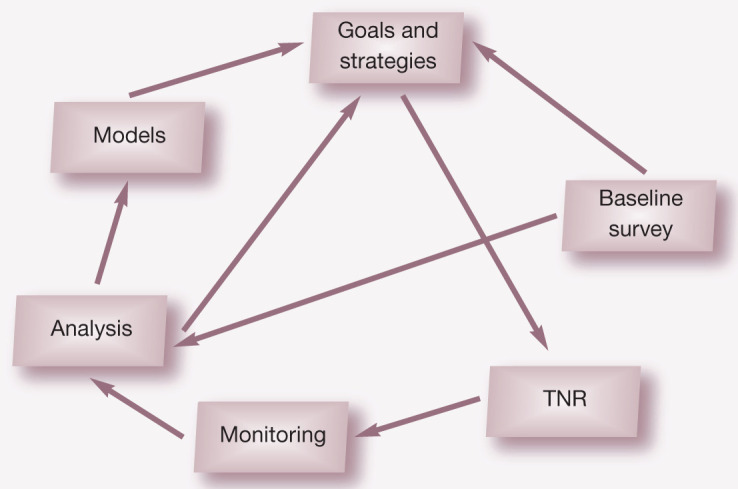
Schematic diagram of a simple adaptive management process for free-roaming cats
It is important to note that although adaptive management is presented in this article primarily as a scientific undertaking, a variety of non-scientific values and viewpoints – along with wildlife conservation concerns – can be formally incorporated into the process of setting goals and formulating strategies. This might be accomplished by periodic consensus-building meetings among stakeholders. It should be noted that management techniques are not necessarily limited to TNR; they may also include parallel initiatives designed to reduce cat abandonment, improve caretaking practices, or engage in partnerships with shelters to remove adoptable cats from an outdoor population.
Suggested practices for TNR programs
For adaptive management to be effective, certain standards and practices should be incorporated into the overall TNR program and strictly adhered to. These include:
Identifying the target population. The population to be managed must be carefully defined in geographical terms (a whole city, specific colonies, entire zip codes, particular city blocks, etc) at the beginning of the TNR program. If possible, the target population should correspond to a natural grouping of cats, rather than comprise some artificially delineated subset of an active metapopulation. This will help to minimize the complicating effects of immigration. This population becomes the sole target of both the TNR effort and the corresponding monitoring effort (although sophisticated monitoring programs may opt to track unmanaged control populations as well).
Baseline survey. An initial baseline survey should be conducted if possible. This allows us to establish a formal, quantitative starting point against which relative population change can be compared. If a population size estimate is also generated as part of the baseline survey, it can provide information that helps to determine the project’s budget, goals and timeline.
Goals. Program goals should be explicitly formulated. Population-level goals could include reducing the current population size by a specified percentage, preventing further increases in population size, or maintaining a stable population while preventing ‘excess’ reproduction. Humane goals could include reducing the number of births, improving the condition and health of cats, and increasing cat lifespans. Making goals explicit allows program successes or shortcoming to be unambiguously classified, and reduces confusion in evaluating program performance.
Ongoing monitoring. As discussed, preparation of a clear monitoring plan should be a prerequisite to investing significant effort in TNR.
Trapping. In its early stages, a trapping effort will tend to capture the most easily trapped cats. Reaching progressively higher sterilization rates may mean finding ways to capture the more trap-savvy cats within a target population. On a per cat basis, therefore, trapping effort will probably rise as we increasingly target those more difficult and less numerous individuals. An effective TNR program must develop techniques and strategies for catching these challenging animals, and must be prepared to devote sufficient effort to these attempts.
Integrated management. TNR, by itself, may not accomplish population size reduction in some situations. Parallel use of ancillary techniques, such as the removal of socialized cats and socializable kittens for adoption, will complement TNR efforts, and may be critical in achieving population size reduction. Additionally, research or experimentation on the best methods to discourage abandonment, by legal means or by education, may further assist the enterprise.
Caretaking standards. Colony management is not the topic of this article, but suffice to note here that TNR programs that aspire to success should consider both the potential positive and potential negative impacts of cat feeding. Feeding efforts that are tailored to population size, as it changes, might help to reduce hunting activity, and discourage cats from roaming widely. Over-provisioning, however, may effectively draw other cats into the managed area, or even encourage the abandonment of cats.
Conclusions
The suggestions in this article are not new, but many are not widely practiced in TNR programs. The impediments to their broad adoption are varied, but may include a reluctance to devote resources to monitoring, and the absence of an effective mechanism for disseminating scientifically derived information to a lay audience. Veterinarians involved in TNR efforts are well positioned to help overcome these impediments and move TNR onto a more productive pathway. The challenges in accomplishing such a transition are quite substantial, but if only a modest portion of the effort currently expended in TNR programs were more productively channeled, as described above, tangible success stories would be more common, and certainly better documented. Maximizing the potential of TNR in this way would also serve empirically and unambiguously to identify the limits of its effectiveness.
This article is based on the premise that a transition to more effective TNR is possible, and on the expectation that broadly applied (as opposed to specifically targeted) lethal removal methods for managing free-roaming cats will not gain wide public acceptance, regardless of potential wildlife benefits. If this is true, then encouraging the improvement of TNR practice, along with concomitant efforts to improve responsible pet stewardship, will ultimately be of more practical benefit to both cats and wildlife than the current polarized and protracted debate between pro-TNR and anti-TNR constituencies.
Many of the recommendations made in this article require only commitment and diligence to implement, not technical training. Certain recommendations, however (particularly those involving initial monitoring design and data analysis), may be more feasibly invoked with some technical assistance. Appropriate expertise is often available in universities or municipal departments of public health or environmental services, and partnerships can be explored to acquire donated services from these sources. Where this is not possible, the author and colleagues from the ACC&D may be able to provide advice or assistance to TNR programs that make a serious commitment to optimizing their management efforts.
Key Points
Trap–neuter–return (TNR) as currently practiced is often not sufficient to reduce the size of targeted cat populations.
By incorporating theoretical knowledge from population models and empirical information from ongoing monitoring, TNR practitioners can substantially improve the efficiency and effectiveness of TNR for population control.
All of the elements of effective TNR should be coordinated under the framework of ‘adaptive management’, in which monitoring data are regularly evaluated to improve the management program.
Improving the effectiveness of TNR could help to mitigate the ongoing controversy over TNR as a management strategy.
By virtue of their technical orientation and frequent involvement in TNR programs, veterinarians are uniquely positioned to promote the adoption of improved TNR practice.
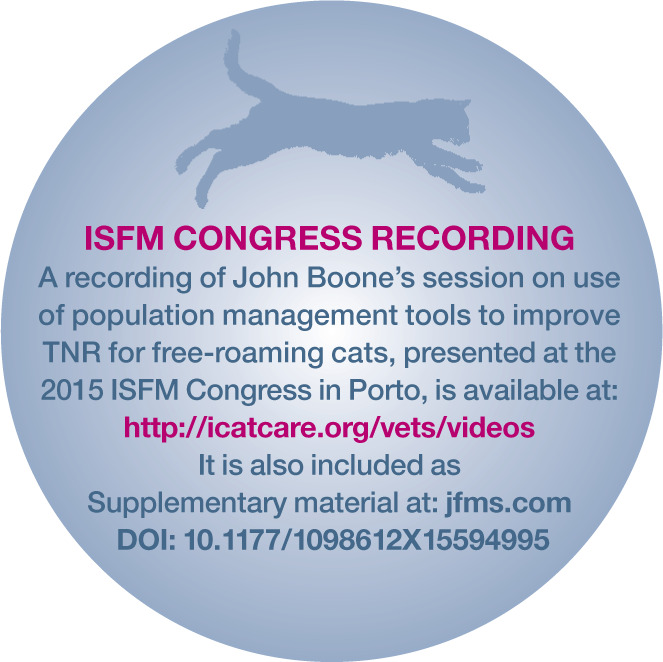
Footnotes
Funding: The author received no specific grant from any funding agency in the public, commercial or not-for-profit sectors for the preparation of this article.
The author has no conflict of interest to declare.
References
- 1. Longcore T, Rich C, Sullivan LM. Critical assessment of claims regarding management of feral cats by trap-neuter-return. Conserv Biol 2009; 23: 887–894. [DOI] [PubMed] [Google Scholar]
- 2. Nutter FB, Levine JF, Stoskopf MK. Reproductive capacity of free-roaming domestic cats and kitten survival rates. J Am Vet Med Assoc 2014; 225: 1399–1402. [DOI] [PubMed] [Google Scholar]
- 3. Miller PS, Boone JD, Briggs JR, et al. Simulating free-roaming cat population management options in open demographic environments. PLoS ONE 2014; 9: e113553. doi: 10.1371/journal.pone.0113553. [DOI] [PMC free article] [PubMed] [Google Scholar]
- 4. Alliance for Contraception in Cats & Dogs. Guidance document: briefly summarizing key findings and their practical application for managing free-roaming cat populations. www.acc-d.org/docs/default-source/think-tanks/guidance-doc-revised-nov-2014.pdf?sfvrsn=0 (2014, accessed June 8, 2015).
- 5. Alliance for Contraception in Cats & Dogs. Counting cats: a generalized population monitoring program to inform the management of free-roaming cats. www.acc-d.org/docs/default-source/think-tanks/frc-monitoring-revised-nov-2014.pdf?sfvrsn=2 (2014, accessed June 8, 2015).
- 6. Sutherland WJ. (ed). Ecological census techniques: a handbook. 2nd ed. Cambridge: Cambridge University Press, 2006. [Google Scholar]



